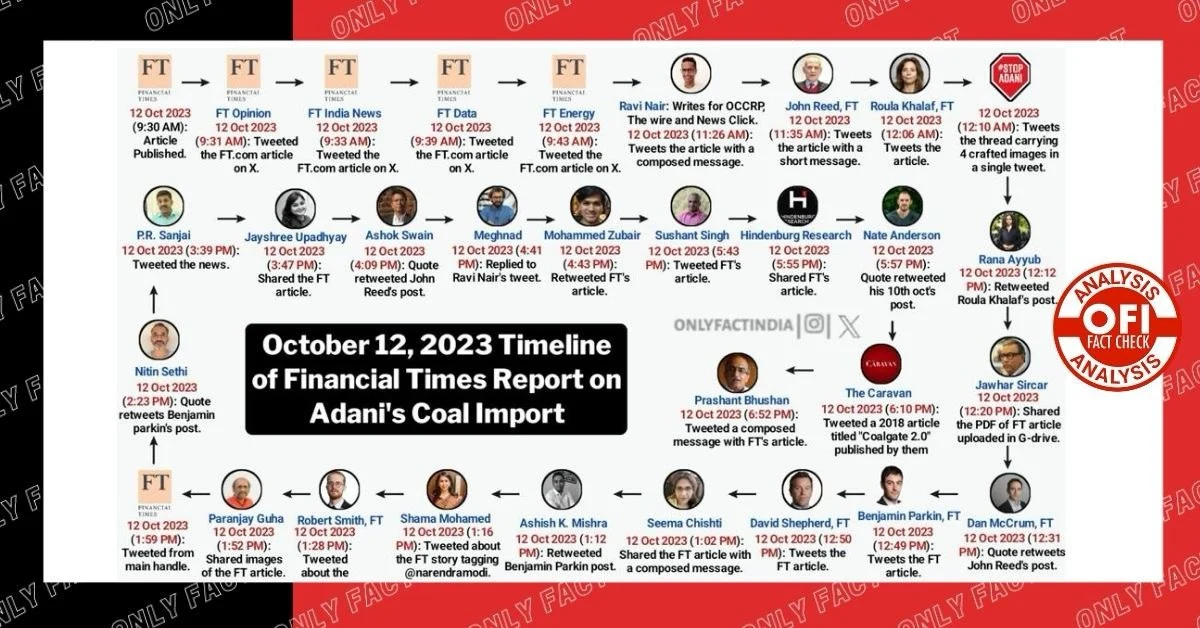In a recent investigation conducted by OnlyFact, a meticulous unravelling of a complex web of propaganda by OCCRP has been brought to light. This sophisticated narrative was intricately woven by influential Western media outlets such as The Financial Times (FT) and The Guardian, both of which derived their ammunition from the OCCRP.
However, resilience proved to be short-lived, as a little over two months later, another web unfolded on the date of October 12, 2023.
Often attributed to Albert Einstein, the insightful adage, “The definition of insanity is doing the same thing over and over and expecting different results.” This axiom finds relevance in the editorial strategy employed by the Financial Times targeting Gautam Adani’s image. The U.K. newspaper exhibited a strategic shift in both approach and timing with their October 12 article assault.
Unlike preceding reports, which delved into intricate financial complexities from the Hindenburg report to the OCCRP report, subjects typically distant from the common populace, this latest offensive centred on the more accessible themes of coal and electricity. The temporal dimension, a crucial element in such narratives, underwent a discernible refinement. The previous article on August 31, published at 4:30 Indian time (around 6:00 pm local time), appeared strategically tailored for a U.S. audience but lacked synchronization with an Indian readership. This seeming oversight was rectified on October 12, with a meticulously timed release at 9:30 am, a strategic adjustment that aimed at capturing the attention of a diverse readership, fostering a more impactful and resonant narrative.
On the 12th of October, the Financial Times, a prominent U.K. newspaper, strategically published the article at 9:30 am. Remarkably, within a brief 15-minute interval, the publication disseminated the same content across five additional official channels. The narrative within these articles levied accusations against the Adani Group, alleging a practice of charging double for coal imports.
In a mere two-minute timeframe, precisely at 9:32 am, the Financial Times’ Opinion X handle promptly disseminated the same article. Contrary to what is written on FT’s opinion bio, which categorically states its commitment to posting selected commentaries on its strictly opinion-centric page, FT Opinion deviated markedly from this professed pledge. In a departure from customary bounds, the handle shared an ostensibly “investigative” and speculative report.
Subsequently, within the following minute, precisely at 9:33 am, the article was shared once again, this time emanating from the FT India X handle.
Six minutes later, the same article found its way to the public domain once more, this time through the FT Data X handle.
At 9:43 am, the FT Energy X handle shared the same article, positing allegations of enigma surrounding coal imports conducted by the Adani Group.
In a span of fewer than 15 minutes, the Financial Times propagated the same article across five distinct platforms. Concluding their dissemination efforts, the baton was then handed over to Indian propagandists, a notable cohort in number. Ravi Nair, a fervent propagandist known for his alignment with communist ideologies and publications supported by Western entities, shared the FT article at precisely 11:26 am. Faced with the obstacle of a paywall, Nair resorted to sharing two screenshots, a manoeuvre seemingly aimed at misleading the public with a potentially spurious report.
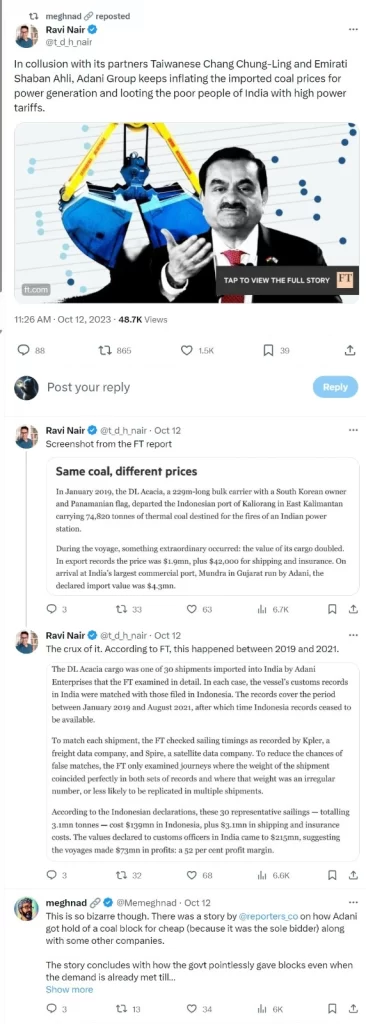
John Reed, the South Asia bureau chief for the Financial Times, strategically shared the FT article via a tweet at precisely 11:35 am. In his tweet, Reed craftily quoted a portion of the article in a manner that appeared to be a shrewd attempt to mislead the Indian populace, asserting that they were bearing an exaggerated cost for electricity because of Gautam Adani.
Roula Khalaf, an editor at the Financial Times, joined the fray in an ongoing propaganda campaign. Despite identifying as an expert in the intricate politics of the Middle East, Khalaf could not resist participating, sharing the article at 12:06 pm.
In a bid to impede Adani’s business ventures in Australia, China payrolled environmental activists rallied behind the cry “Stop Adani.” This slogan subsequently manifested as a Twitter account boasting 15.7k followers, which, at 12:10 pm, shared the article from the Financial Times.
Rana Ayyub, whose livelihood centres on writing with a singular objective of tarnishing India’s image, and whose book on the Gujarat riots was discredited by the court as a product of capricious imagination, known for vulture capitalizing on funds meant for the impoverished, retweeted the FT article on three occasions.

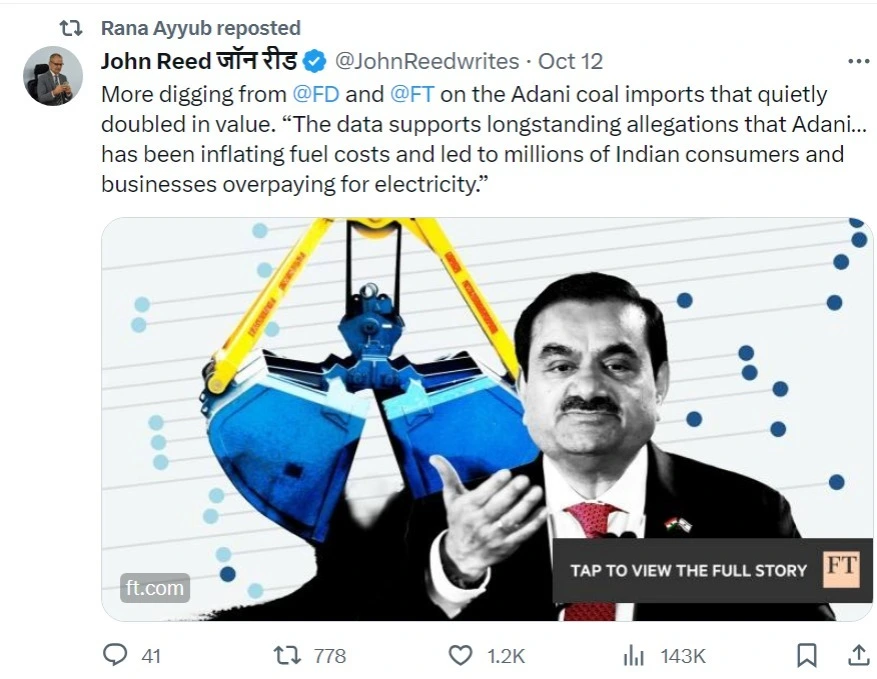
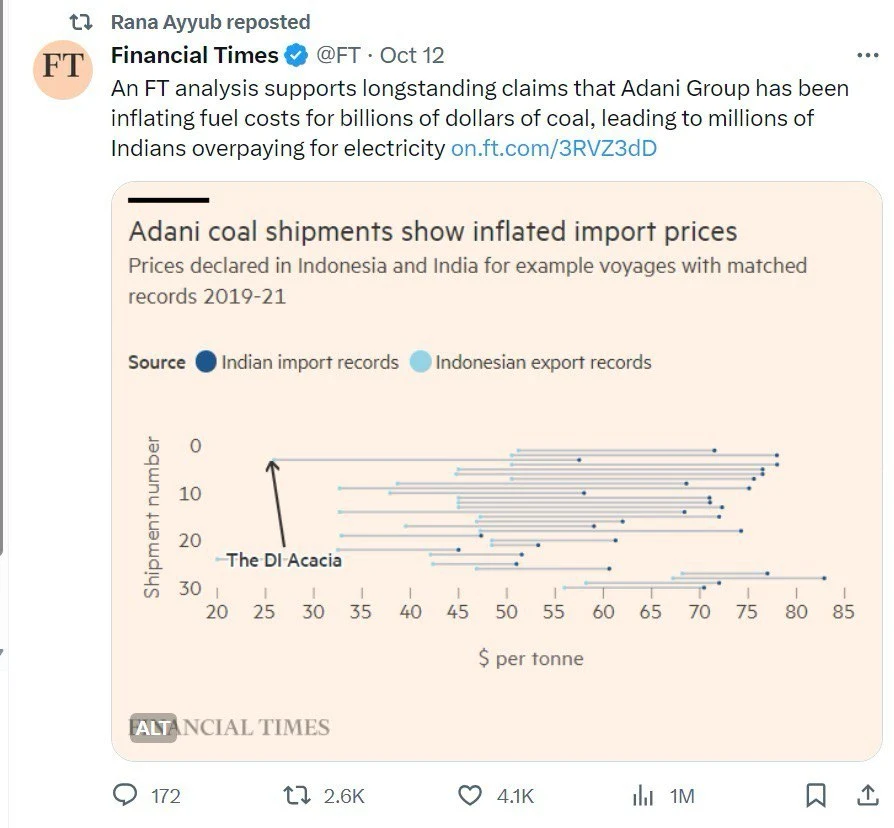
Jawahar Sircar, a Member of Parliament in the Rajya Sabha, renowned for his strong aversion towards Prime Minister Modi, shared the Financial Times article at 12:20 pm. Sircar lauded the team at FT responsible for the article, expressing his frustration when his sentiments garnered limited attention. Going a step further, the Rajya Sabha MP shared the article through his Google Drive, aiming to facilitate widespread dissemination given the perceived impediment posed by FT’s paywall to their propaganda machinery.
Dan McCrum, assigned the role of co-authoring the propagandistic article, referenced John Reed’s tweet at 12:31 pm. In his tweet, McCrum artfully employed language imbued with elements of suspense, secrecy, and speculation, adding a nuanced layer to the narrative.
Benjamin Parkin, the South Asia bureau correspondent for the Financial Times, shared the article via a tweet at 12:49 pm. Additionally, Editor-in-Chief at Morning Context, Ashish K. Mishra retweeted Parkin’s tweet.
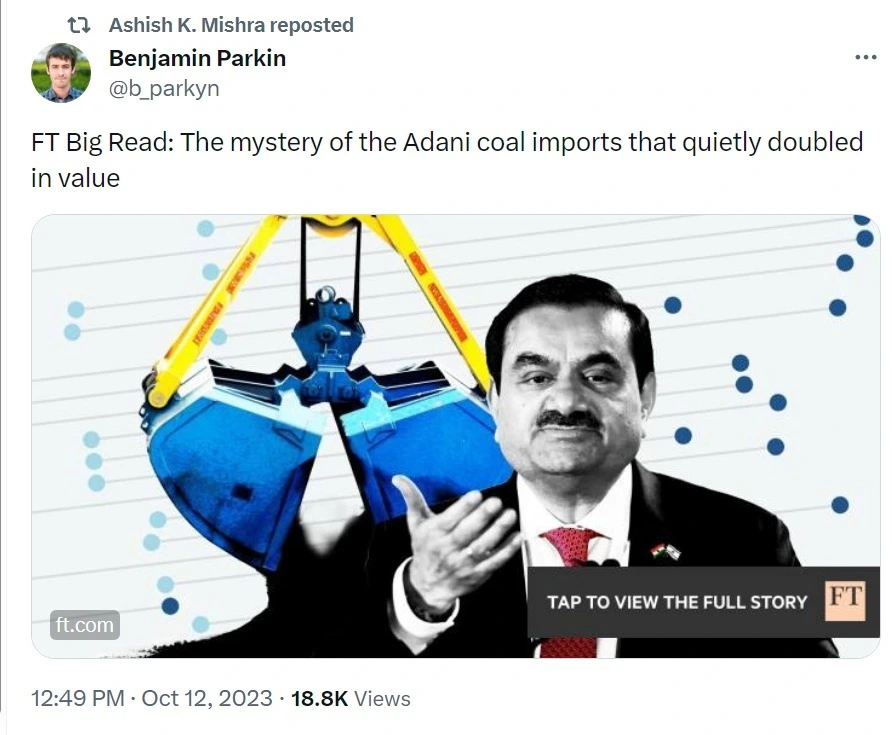
David Shepherd, the Energy Editor at the Financial Times, shared the article at 12:50 pm, contributing to the broader circulation of the misinformation.
Should there be any lingering skepticism regarding the nature of the Financial Times article as a platform for communist propaganda, the inclusion of Seema Chishti in the narrative serves to dispel all uncertainties. As the spouse of a prominent figure within the communist party and an editor affiliated with a media outlet aligned with communist ideologies, Chishti shared the article at 1:02 pm.
Congress spokesperson Dr. Shama Mohamed took to Twitter at 1:16 pm to share insights on the Financial Times article. In an assertive move, Dr. Mohamed not only shared the content but also went a step further, levying accusations and alleging a connection between Prime Minister Modi and Gautam Adani and a purported scam. The words articulated by Dr. Mohamed seemed to be drawn directly from the insinuations presented in the propaganda article, raising the inference that a Congress leader was providing a verbal framework for foreign-initiated propaganda.
At 1:28 pm, Financial Times journalist Robert Smith shared the article.
Following a concerted and coordinated endeavour to disseminate the propaganda piece through various FT X handles, the main Financial Times handle took up the mantle at 1:59 pm.
Nitin Sethi, a journalist affiliated with Reporters Collective, expressed his perspectives on the Financial Times article at 2:23 pm. His commentary involved quoting Benjamin Parkin.
Raju Parulekar, a writer known for catering to his followers with communist-Islamist leanings through the sharing of narratives against Hindus and Prime Minister Modi, shared the Financial Times article at 3:02 pm. Parulekar’s engagement involved quoting journalist Abir Dasgupta.
Following the lead of Financial Times, another journalist, from the international media platform Bloomberg, entered the discourse by sharing the article. P.R. Sanjal took to social media at 3:39 pm, strategically attempting to resonate with the Indian audience by reinforcing the narrative surrounding the purportedly exorbitant electricity costs.
Subsequent to Bloomberg’s involvement, journalist Jayshree P. Upadhyay from Reuters entered the realm of disseminating the propaganda, sharing the article at 3:47 pm.
Ashok Swain, a prolific critic of Hinduism and India, did not refrain from engaging in the propaganda. Swain shared the article at 4:09 pm, aligning himself with the narrative propagated therein.
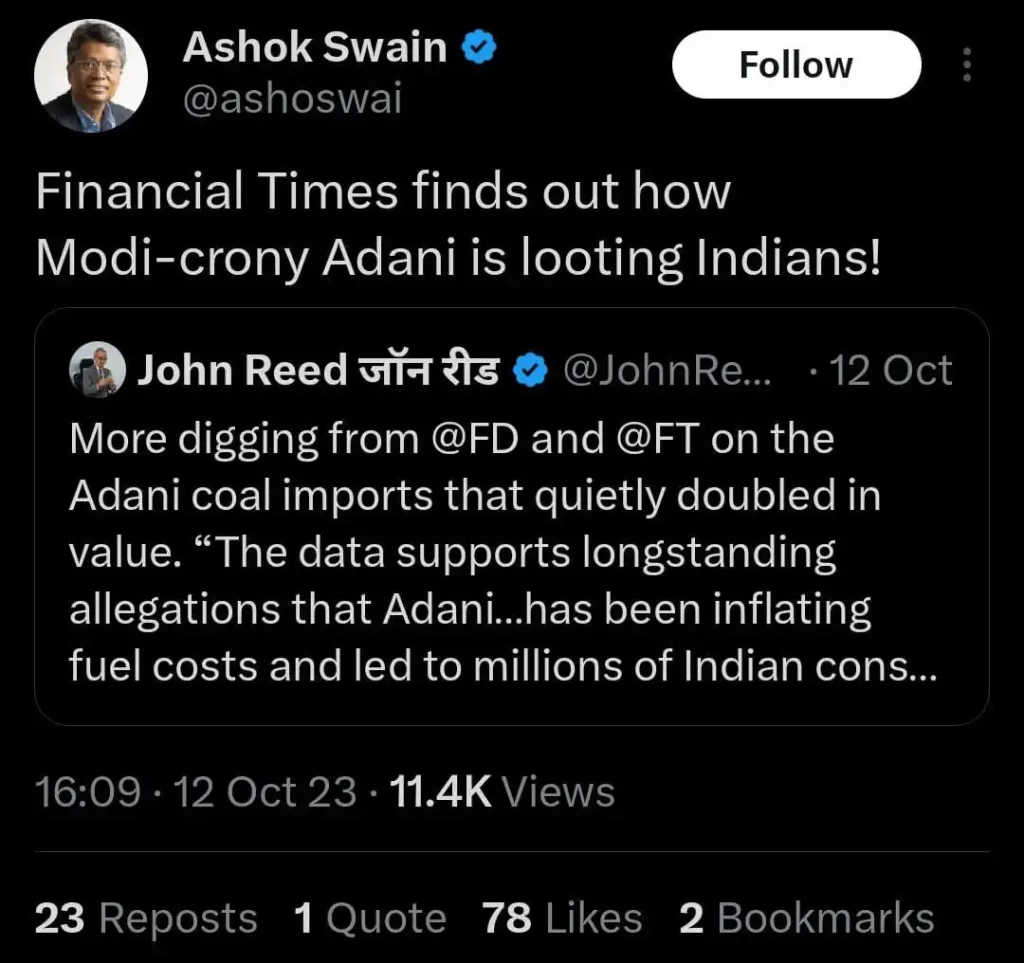
Indian YouTuber Meghnad, whose ideological alignment leans staunchly towards communism, engaged in the discourse by responding to Ravi Nair’s tweet at 4:41 pm. Adding an additional layer to the narrative propaganda, Meghnad furthered by sharing an article from Reporters Collective.
Muhammad Zubair, identified as an ardent Islamist with indirect ties to several tragic incidents, including the unfortunate beheadings of innocent Hindus, and also serving as a co-founder of Alt News, shared the Financial Times article through a retweet at 4:43 pm.
Sushant Singh, Consulting Editor at The Caravan, shared the article at 5:43 pm.
In a culmination of events, Hindenburg Reports, previously discredited by the Supreme Court and cautioned against being considered factual, shared the Financial Times article at 5:55 pm. This move signified the organization’s reentry into actively promoting an agenda, having played a significant role in shaping the narrative.
In swift succession following Hindenburg’s social media post, their preferred hit-man Nate Anderson, shared the Financial Times article at 5:57 pm, aligning with their strategic narrative.
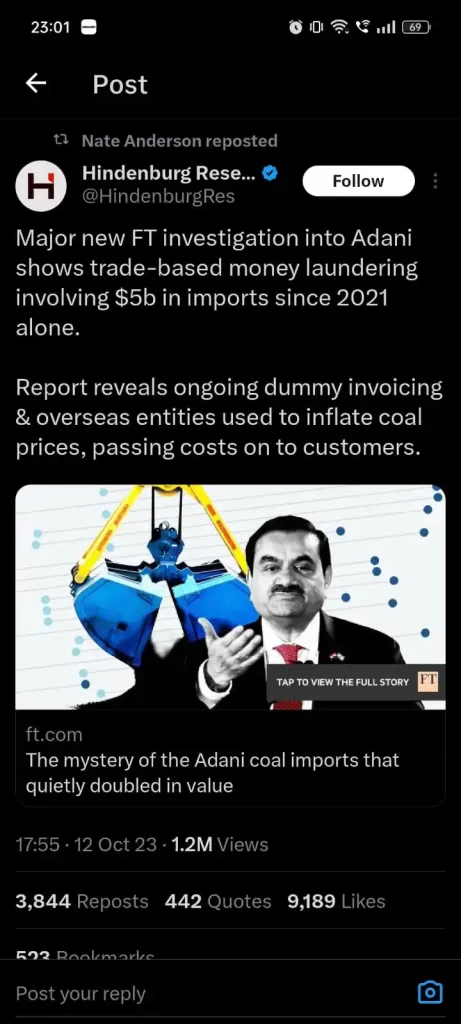
In the unfolding narrative, lawyer Prashant Bhushan entered the discourse by sharing the Financial Times article at 6:52 pm. Notably, the Supreme Court of India has recently reiterated its dismissal of Bhushan’s position on the Adani matter, emphasizing that the articles from both the Financial Times and The Hindenburg lack the requisite credibility to be deemed as reliable evidence.
The Caravan magazine, recognized for frequently presenting an anti-government perspective, shared the Financial Times article at 6:10 pm, thereby aligning itself with the prevailing propaganda.
Tanmoy, a Leftist X user known for disseminating communist propaganda, shared the Financial Times article at 9:32 pm. In a rhetorical move, Tanmoy subtly critiqued Prime Minister Modi while amplifying the narrative contained in the article against Gautam Adani.
Paranjoy Guha Thakurta, the founder and editor of Newsclick, a figure previously implicated in allegations of financial impropriety and accused of receiving funds from the Chinese communist regime to advance their agenda, shared the Financial Times article at 9:33 pm.
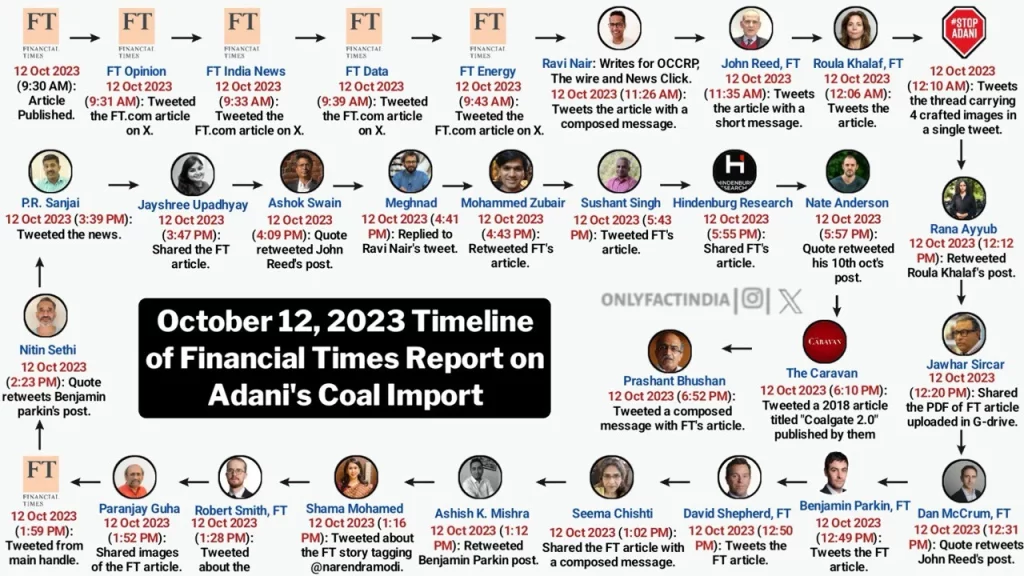
Similar to the prior propaganda orchestrated on August 31st, the offensive launched on October 10th exhibited significant continuity in its cast of participants. Although the methodology may have evolved, the practitioner’s skill remained constant. In the October campaign, Financial Times orchestrated an orchestrated engagement, deploying all of their X handles and enlisting nearly every journalist and editor with a notable following on these platforms to propagate their narrative. Similar to its antecedent, this initiative also dissipated within a day.
Notably, the Financial Times recently removed the paywall surrounding the coal article, strategically assigning the task of widespread dissemination to parliamentarian Mahua Moitra. One need not possess heightened olfactory senses to detect the pervasive odour of a meticulously crafted conspiracy.
Also Read: Financial Times allegation on Adani Group Exposed, Link Rooted to George Soros

